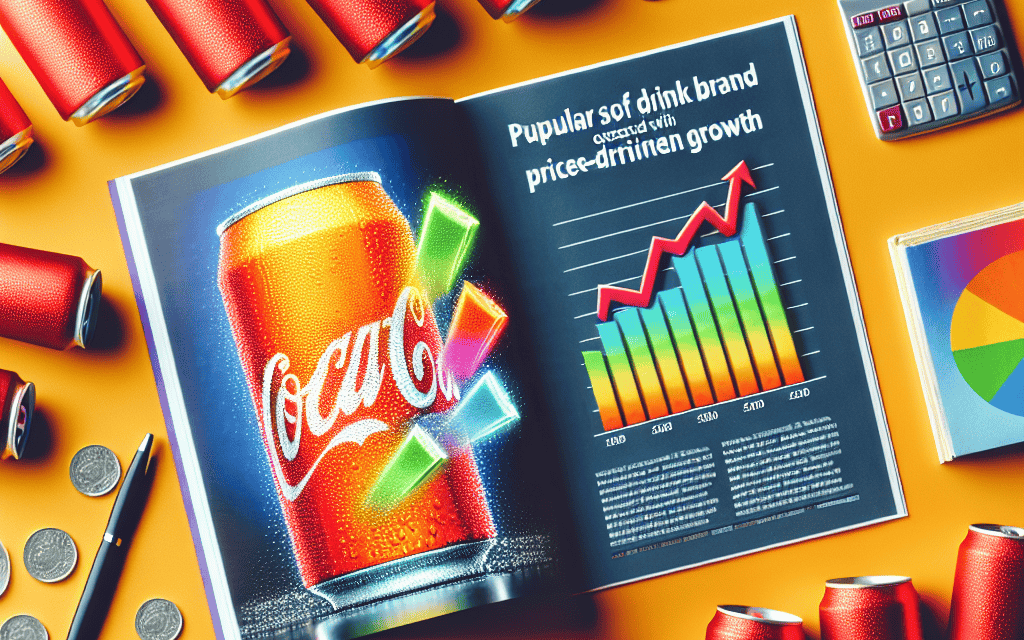“Coca-Cola Fizzes Ahead: Q3 Success Sparked by Strategic Price Surge”
Introduction
In the third quarter, Coca-Cola surpassed market expectations, driven primarily by strategic price increases that bolstered its revenue growth. The beverage giant reported a significant rise in sales, attributing the performance to its ability to effectively manage pricing strategies amidst a challenging economic landscape. This approach not only offset the impact of fluctuating commodity costs but also capitalized on strong consumer demand across its diverse product portfolio. As a result, Coca-Cola’s financial results for the quarter reflect a robust operational execution, reinforcing its position as a leader in the global beverage industry.
Coca-Cola’s Strategic Pricing Boosts Q3 Revenue
Coca-Cola has once again demonstrated its resilience and strategic acumen by exceeding market expectations in the third quarter, driven primarily by its adept pricing strategies. As the global economic landscape continues to grapple with inflationary pressures and fluctuating consumer demand, Coca-Cola’s ability to navigate these challenges and deliver robust financial performance underscores its position as a leader in the beverage industry. The company’s third-quarter results reveal a significant increase in revenue, attributed largely to strategic price adjustments across various markets.
In an environment where many companies are struggling to maintain profitability, Coca-Cola’s decision to implement price hikes has proven to be a prudent move. By carefully analyzing market conditions and consumer behavior, the company has managed to strike a balance between maintaining affordability and ensuring profitability. This approach has not only bolstered its revenue but also reinforced its brand value in the eyes of consumers who continue to show loyalty despite the price increases. The company’s ability to sustain demand amidst higher prices is a testament to its strong brand equity and the perceived value of its products.
Moreover, Coca-Cola’s strategic pricing has been complemented by its ongoing efforts to innovate and diversify its product offerings. The introduction of new flavors and healthier options has attracted a broader consumer base, further driving sales. This diversification strategy has allowed Coca-Cola to tap into emerging trends and cater to a more health-conscious audience, thereby expanding its market reach. The company’s commitment to innovation is evident in its investment in research and development, which has facilitated the creation of products that resonate with contemporary consumer preferences.
In addition to product innovation, Coca-Cola’s focus on enhancing operational efficiency has played a crucial role in its third-quarter success. By optimizing its supply chain and leveraging technology, the company has managed to reduce costs and improve margins. This operational agility has enabled Coca-Cola to respond swiftly to market changes and maintain a competitive edge. Furthermore, the company’s strategic partnerships and acquisitions have strengthened its distribution network, ensuring that its products are readily available to consumers worldwide.
Coca-Cola’s performance in the third quarter also highlights the importance of its global footprint. With operations in over 200 countries, the company has been able to mitigate regional economic fluctuations by capitalizing on growth opportunities in diverse markets. This geographic diversification has provided a buffer against localized downturns and allowed Coca-Cola to sustain its growth trajectory. The company’s ability to adapt its strategies to suit different market dynamics is a key factor in its continued success.
Looking ahead, Coca-Cola remains optimistic about its growth prospects, despite the ongoing economic uncertainties. The company is committed to further enhancing its product portfolio and exploring new market opportunities. By continuing to prioritize innovation and operational excellence, Coca-Cola aims to maintain its momentum and deliver value to shareholders. The company’s strategic focus on pricing, coupled with its robust brand and global presence, positions it well to navigate future challenges and capitalize on emerging trends.
In conclusion, Coca-Cola’s impressive third-quarter performance is a testament to its strategic foresight and operational prowess. By effectively leveraging pricing strategies, product innovation, and operational efficiency, the company has not only exceeded market expectations but also reinforced its status as a leader in the beverage industry. As Coca-Cola continues to adapt to the evolving market landscape, its commitment to delivering quality products and value to consumers remains unwavering.
Analyzing Coca-Cola’s Q3 Financial Performance
Coca-Cola’s third-quarter financial performance has surpassed market expectations, driven primarily by strategic price adjustments that have bolstered revenue growth. The beverage giant reported a notable increase in its quarterly earnings, reflecting its adeptness at navigating the complexities of a challenging economic landscape. This performance underscores Coca-Cola’s resilience and adaptability in the face of fluctuating consumer demand and global economic uncertainties.
The company’s ability to exceed expectations can be attributed to its strategic pricing initiatives, which have played a pivotal role in offsetting the pressures of rising costs. By implementing price hikes across various markets, Coca-Cola has managed to maintain its profit margins while continuing to deliver value to its shareholders. This approach has proven effective in counterbalancing the impact of inflationary pressures on raw materials and transportation costs, which have been a significant concern for many global corporations.
Moreover, Coca-Cola’s diverse product portfolio has been instrumental in driving its financial success. The company has continued to innovate and expand its offerings, catering to a wide range of consumer preferences. This diversification strategy has not only helped in capturing a broader market share but also in mitigating risks associated with dependency on a single product line. The introduction of new flavors and health-conscious options has resonated well with consumers, further enhancing the brand’s appeal and market presence.
In addition to pricing strategies and product diversification, Coca-Cola’s focus on expanding its digital and direct-to-consumer channels has contributed to its robust performance. The company has invested significantly in enhancing its digital capabilities, enabling it to engage more effectively with consumers and streamline its supply chain operations. This digital transformation has facilitated better customer insights, allowing Coca-Cola to tailor its marketing efforts and product offerings to meet evolving consumer needs.
Furthermore, Coca-Cola’s commitment to sustainability and corporate social responsibility has reinforced its brand image, fostering consumer loyalty and trust. The company’s initiatives aimed at reducing its environmental footprint, such as increasing the use of recycled materials and improving water efficiency, have resonated with environmentally conscious consumers. This alignment with global sustainability trends has not only enhanced Coca-Cola’s reputation but also positioned it favorably in the competitive beverage industry.
While the company’s third-quarter performance is commendable, it is essential to acknowledge the challenges that lie ahead. The global economic environment remains uncertain, with potential headwinds such as geopolitical tensions, supply chain disruptions, and fluctuating currency exchange rates. Coca-Cola’s ability to navigate these challenges will be crucial in sustaining its growth trajectory and maintaining its competitive edge.
In conclusion, Coca-Cola’s impressive third-quarter financial performance is a testament to its strategic foresight and operational excellence. By leveraging price-driven growth, diversifying its product offerings, and embracing digital transformation, the company has successfully navigated a complex economic landscape. As Coca-Cola continues to innovate and adapt to changing market dynamics, its commitment to sustainability and consumer engagement will remain central to its long-term success. The company’s ability to balance these elements will be pivotal in shaping its future performance and reinforcing its position as a leader in the global beverage industry.
How Price Adjustments Led to Coca-Cola’s Q3 Success
In the third quarter of the fiscal year, Coca-Cola has surpassed market expectations, demonstrating a robust performance primarily driven by strategic price adjustments. This success story is a testament to the company’s adeptness at navigating the complex landscape of global markets, where inflationary pressures and fluctuating consumer demands pose significant challenges. By implementing well-calibrated price increases, Coca-Cola has not only managed to maintain its market position but also enhance its profitability, thereby exceeding analysts’ forecasts.
The decision to adjust prices was not made in isolation but was part of a broader strategy to counterbalance rising production costs. With the global economy experiencing significant inflationary trends, the cost of raw materials, transportation, and labor has surged. Coca-Cola, like many other companies, faced the dilemma of absorbing these costs or passing them on to consumers. Opting for the latter, the company executed a series of price hikes across various markets. These adjustments were carefully tailored to each region, taking into account local economic conditions and consumer purchasing power, thus ensuring minimal disruption to sales volumes.
Moreover, Coca-Cola’s ability to exceed expectations can also be attributed to its strong brand equity and diversified product portfolio. The company has long been a household name, and its products enjoy a loyal customer base. This brand loyalty has provided Coca-Cola with the leverage needed to implement price increases without significantly affecting consumer demand. Additionally, the company’s extensive range of beverages, which includes not only carbonated drinks but also juices, teas, and energy drinks, has allowed it to cater to a wide array of consumer preferences. This diversification has been instrumental in mitigating the impact of price changes on overall sales.
Furthermore, Coca-Cola’s strategic marketing initiatives have played a crucial role in sustaining consumer interest and driving sales. The company has invested heavily in digital marketing and innovative advertising campaigns, which have resonated well with consumers, particularly younger demographics. By leveraging social media platforms and engaging in partnerships with popular influencers, Coca-Cola has successfully maintained its brand visibility and appeal, even amidst price adjustments.
In addition to these efforts, Coca-Cola’s commitment to sustainability and corporate responsibility has bolstered its reputation and consumer trust. The company has made significant strides in reducing its environmental footprint, with initiatives aimed at improving water efficiency, reducing plastic waste, and promoting recycling. These efforts have not only enhanced Coca-Cola’s brand image but have also aligned with the growing consumer preference for environmentally conscious brands, thereby supporting its sales growth.
Looking ahead, Coca-Cola’s performance in the third quarter sets a positive precedent for the remainder of the fiscal year. The company’s ability to effectively manage pricing strategies while maintaining consumer loyalty and expanding its market reach underscores its resilience and adaptability in a challenging economic environment. As Coca-Cola continues to innovate and refine its strategies, it remains well-positioned to navigate future market dynamics and sustain its growth trajectory.
In conclusion, Coca-Cola’s Q3 success is a clear indication of the efficacy of its price-driven growth strategy. By skillfully balancing price adjustments with brand strength, product diversification, and strategic marketing, the company has not only met but exceeded market expectations, reinforcing its status as a leader in the global beverage industry.
Coca-Cola’s Growth Strategy: A Q3 Case Study

Coca-Cola’s recent performance in the third quarter has demonstrated the effectiveness of its strategic initiatives, particularly in leveraging price-driven growth to exceed market expectations. The beverage giant reported a notable increase in revenue, attributing much of this success to strategic price adjustments across its diverse product portfolio. This approach has not only bolstered the company’s financial performance but also reinforced its position in the competitive global beverage market.
The company’s ability to navigate the complexities of the current economic landscape is a testament to its robust growth strategy. In an environment characterized by inflationary pressures and fluctuating consumer demand, Coca-Cola’s decision to implement price increases was a calculated move. By carefully analyzing market trends and consumer behavior, the company was able to adjust its pricing strategy without significantly impacting demand. This delicate balance between price and volume has been crucial in driving revenue growth while maintaining customer loyalty.
Moreover, Coca-Cola’s focus on premiumization has played a significant role in its Q3 success. By enhancing the perceived value of its products, the company has been able to justify price increases to consumers who are increasingly seeking quality and unique experiences. This shift towards premium offerings is evident in the expansion of Coca-Cola’s product lines, including the introduction of new flavors and limited-edition products that cater to evolving consumer preferences. As a result, the company has not only attracted new customers but also encouraged existing ones to explore its diverse range of beverages.
In addition to price adjustments and premiumization, Coca-Cola’s commitment to innovation has been a driving force behind its impressive Q3 performance. The company has consistently invested in research and development to create new products that resonate with consumers. This focus on innovation is reflected in the successful launch of several new beverages that have quickly gained popularity in various markets. By staying ahead of consumer trends and continuously refreshing its product offerings, Coca-Cola has managed to maintain its competitive edge and drive sustained growth.
Furthermore, Coca-Cola’s strategic partnerships and acquisitions have contributed to its robust Q3 results. By collaborating with other companies and acquiring complementary brands, Coca-Cola has expanded its market reach and diversified its product portfolio. These strategic moves have enabled the company to tap into new consumer segments and explore emerging markets, thereby enhancing its growth potential. The integration of these new brands into Coca-Cola’s existing operations has been seamless, further strengthening the company’s market position.
Coca-Cola’s success in the third quarter also underscores the importance of effective supply chain management. The company has demonstrated resilience in the face of global supply chain disruptions by optimizing its logistics and distribution networks. By ensuring the timely delivery of products to retailers and consumers, Coca-Cola has maintained its market presence and minimized potential revenue losses. This proactive approach to supply chain management has been instrumental in supporting the company’s growth strategy.
In conclusion, Coca-Cola’s impressive Q3 performance is a reflection of its well-executed growth strategy, which emphasizes price-driven growth, premiumization, innovation, strategic partnerships, and effective supply chain management. By adapting to changing market conditions and consumer preferences, Coca-Cola has not only exceeded expectations but also reinforced its position as a leader in the global beverage industry. As the company continues to navigate the challenges of the current economic environment, its strategic initiatives are likely to drive sustained growth and success in the future.
The Impact of Pricing on Coca-Cola’s Q3 Results
In the third quarter of 2023, Coca-Cola demonstrated a robust financial performance, surpassing market expectations primarily through strategic pricing initiatives. This achievement underscores the company’s adeptness at navigating a challenging economic landscape marked by inflationary pressures and fluctuating consumer demand. As the global economy continues to grapple with these challenges, Coca-Cola’s ability to leverage pricing as a growth driver highlights its resilience and strategic foresight.
The beverage giant reported a notable increase in revenue, attributing much of this growth to price adjustments rather than volume expansion. This strategic focus on pricing allowed Coca-Cola to offset rising costs associated with raw materials and supply chain disruptions. By carefully calibrating its pricing strategy, the company managed to maintain its profit margins while still appealing to a broad consumer base. This approach not only safeguarded its financial health but also reinforced its market position amidst intense competition.
Moreover, Coca-Cola’s pricing strategy was not implemented in isolation but was part of a broader, more comprehensive approach to value creation. The company has been investing in brand innovation and marketing to enhance consumer perception and loyalty. By introducing new product variants and limited-edition offerings, Coca-Cola has successfully created a sense of exclusivity and urgency, encouraging consumers to accept higher price points. This strategy has been particularly effective in emerging markets, where brand loyalty and consumer preferences are rapidly evolving.
In addition to product innovation, Coca-Cola has also focused on optimizing its distribution channels to ensure that its products remain accessible to consumers despite price increases. By strengthening its partnerships with retailers and investing in digital platforms, the company has enhanced its supply chain efficiency and expanded its reach. This multi-faceted approach has enabled Coca-Cola to maintain a delicate balance between pricing and accessibility, ensuring that its products remain within reach for a diverse consumer demographic.
Furthermore, Coca-Cola’s success in Q3 can also be attributed to its commitment to sustainability and corporate responsibility. As consumers become increasingly conscious of environmental and social issues, Coca-Cola has made significant strides in aligning its business practices with these values. By investing in sustainable packaging solutions and reducing its carbon footprint, the company has not only enhanced its brand image but also justified its pricing strategy to a more discerning consumer base. This alignment with consumer values has been instrumental in driving brand loyalty and, consequently, financial performance.
While the focus on pricing has been a key driver of Coca-Cola’s Q3 success, it is important to recognize the potential risks associated with this strategy. As the company continues to rely on price increases to drive growth, it must remain vigilant to the risk of alienating price-sensitive consumers. To mitigate this risk, Coca-Cola must continue to innovate and adapt its product offerings to meet the evolving needs and preferences of its consumers. By doing so, the company can ensure that its pricing strategy remains sustainable in the long term.
In conclusion, Coca-Cola’s impressive Q3 performance is a testament to its strategic acumen and ability to adapt to a dynamic economic environment. Through a well-executed pricing strategy, coupled with innovation and a commitment to sustainability, the company has successfully navigated the challenges of the current market landscape. As Coca-Cola looks to the future, it must continue to balance pricing with consumer value to sustain its growth trajectory and maintain its position as a leader in the global beverage industry.
Coca-Cola’s Q3 Earnings: A Price-Driven Triumph
Coca-Cola’s third-quarter earnings report has revealed a remarkable performance, surpassing market expectations and showcasing the company’s adeptness at navigating a challenging economic landscape. The beverage giant’s success in this quarter can be largely attributed to strategic price increases, which have effectively bolstered revenue despite a backdrop of fluctuating consumer demand and global economic uncertainties. As the company continues to adapt to evolving market conditions, its ability to leverage pricing strategies has proven to be a key driver of growth.
In the third quarter, Coca-Cola reported a significant increase in revenue, driven primarily by higher pricing across its product portfolio. This strategic move has allowed the company to offset rising costs associated with raw materials and supply chain disruptions, which have been prevalent in the current economic climate. By carefully calibrating price adjustments, Coca-Cola has managed to maintain its competitive edge while ensuring that its products remain accessible to a broad consumer base. This delicate balance between pricing and consumer affordability has been instrumental in the company’s ability to exceed earnings expectations.
Moreover, Coca-Cola’s diverse product range has played a crucial role in its third-quarter success. The company has continued to innovate and expand its offerings, catering to a wide array of consumer preferences and dietary needs. This diversification strategy has not only enhanced Coca-Cola’s market presence but also mitigated risks associated with reliance on a single product category. As a result, the company has been able to capture a larger share of the market, further contributing to its robust financial performance.
In addition to price-driven growth, Coca-Cola’s strategic investments in marketing and brand development have also been pivotal in reinforcing its market position. The company has consistently focused on enhancing brand loyalty and consumer engagement through targeted marketing campaigns and strategic partnerships. These efforts have not only strengthened Coca-Cola’s brand equity but have also driven increased consumer demand, thereby supporting the company’s revenue growth.
Furthermore, Coca-Cola’s commitment to sustainability and corporate responsibility has resonated well with consumers, particularly in an era where environmental and social considerations are increasingly influencing purchasing decisions. The company’s initiatives to reduce its carbon footprint, promote recycling, and support community development have enhanced its reputation as a socially responsible corporation. This positive brand image has, in turn, contributed to consumer trust and loyalty, further underpinning Coca-Cola’s financial success.
Looking ahead, Coca-Cola remains well-positioned to sustain its growth trajectory, despite potential challenges in the global economic environment. The company’s focus on innovation, strategic pricing, and brand development will continue to be key pillars of its growth strategy. Additionally, Coca-Cola’s ability to adapt to changing consumer preferences and market dynamics will be crucial in maintaining its competitive advantage.
In conclusion, Coca-Cola’s third-quarter performance is a testament to the company’s strategic acumen and resilience in the face of economic headwinds. By effectively leveraging price-driven growth, diversifying its product offerings, and investing in brand development, Coca-Cola has not only exceeded market expectations but has also reinforced its position as a leader in the global beverage industry. As the company continues to navigate the complexities of the current economic landscape, its commitment to innovation and sustainability will undoubtedly play a vital role in shaping its future success.
Understanding Coca-Cola’s Q3 Market Dynamics
In the third quarter of 2023, Coca-Cola demonstrated a robust performance that exceeded market expectations, primarily driven by strategic pricing initiatives. This achievement underscores the company’s adeptness at navigating a complex economic landscape characterized by fluctuating consumer preferences and inflationary pressures. As the global economy continues to grapple with these challenges, Coca-Cola’s ability to leverage its brand strength and pricing power has proven instrumental in sustaining its growth trajectory.
The company’s Q3 results reveal a nuanced understanding of market dynamics, where price adjustments played a pivotal role in offsetting increased production costs. By strategically raising prices, Coca-Cola managed to enhance its revenue streams without significantly dampening consumer demand. This delicate balance between pricing and demand is a testament to the brand’s enduring appeal and the effectiveness of its marketing strategies. Moreover, the company’s diverse product portfolio, which includes a range of beverages catering to various consumer tastes and preferences, has further bolstered its market position.
In addition to pricing strategies, Coca-Cola’s focus on innovation and product diversification has been a key driver of its Q3 success. The introduction of new products and the expansion of existing lines have allowed the company to capture a broader audience, thereby increasing its market share. For instance, the growing consumer interest in health-conscious options has prompted Coca-Cola to invest in low-sugar and zero-calorie beverages, aligning its offerings with evolving consumer trends. This proactive approach not only enhances customer satisfaction but also positions the company favorably in a competitive market.
Furthermore, Coca-Cola’s global reach and strong distribution network have been critical in capitalizing on emerging market opportunities. The company’s ability to adapt its strategies to local market conditions has enabled it to tap into new revenue streams and mitigate risks associated with regional economic fluctuations. By tailoring its product offerings and marketing campaigns to resonate with local consumers, Coca-Cola has effectively strengthened its brand presence across diverse geographies.
While the company’s Q3 performance is commendable, it is essential to consider the broader economic context in which these results were achieved. Inflationary pressures and supply chain disruptions have posed significant challenges for businesses worldwide, including Coca-Cola. However, the company’s strategic foresight and operational resilience have allowed it to navigate these hurdles effectively. By optimizing its supply chain operations and implementing cost-control measures, Coca-Cola has managed to maintain profitability while ensuring product availability.
Looking ahead, Coca-Cola’s ability to sustain its growth momentum will depend on its continued focus on innovation, market adaptation, and strategic pricing. As consumer preferences evolve and economic conditions remain uncertain, the company must remain agile and responsive to emerging trends. By leveraging its brand equity and investing in sustainable practices, Coca-Cola can further solidify its position as a leader in the global beverage industry.
In conclusion, Coca-Cola’s Q3 performance highlights the company’s strategic acumen in leveraging price-driven growth amidst challenging market conditions. Through a combination of pricing strategies, product innovation, and market adaptation, Coca-Cola has not only exceeded expectations but also reinforced its commitment to delivering value to consumers and shareholders alike. As the company continues to navigate the complexities of the global market, its focus on long-term growth and sustainability will be crucial in maintaining its competitive edge.
Q&A
1. **What was Coca-Cola’s performance in Q3?**
Coca-Cola exceeded expectations in Q3 with strong financial results.
2. **What drove Coca-Cola’s growth in Q3?**
The growth was primarily driven by price increases.
3. **How did Coca-Cola’s revenue compare to forecasts?**
Coca-Cola’s revenue surpassed analysts’ forecasts.
4. **What impact did price increases have on Coca-Cola’s sales volume?**
Despite price increases, Coca-Cola maintained stable sales volume.
5. **Did Coca-Cola’s earnings per share (EPS) meet expectations?**
Coca-Cola’s EPS exceeded market expectations.
6. **How did Coca-Cola’s stock react to the Q3 results?**
Coca-Cola’s stock saw a positive reaction following the Q3 results.
7. **What are Coca-Cola’s future growth strategies?**
Coca-Cola plans to continue focusing on premium product offerings and expanding its market presence.
Conclusion
In the third quarter, Coca-Cola surpassed market expectations, primarily driven by strategic price increases that bolstered revenue growth. Despite potential challenges such as fluctuating consumer demand and economic uncertainties, the company’s ability to effectively implement pricing strategies without significantly impacting sales volume highlights its strong brand equity and market positioning. This performance underscores Coca-Cola’s resilience and adaptability in navigating a competitive beverage industry landscape, setting a positive outlook for future quarters.





